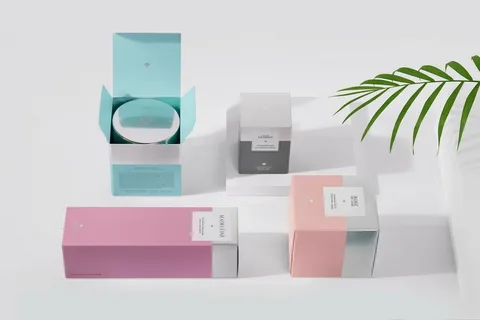business-services

July 10,2025 • 7 min read
The Beginner’s Guide to Choosing the Right Custom Cosmetic Packaging

The Beginner’s Guide to Choosing the Right Custom Cosmetic Packaging
In the highly competitive world of cosmetics, packaging is more than just a protective layer. It's a vital part of branding, marketing, and customer experience. Custom cosmetic packaging plays a pivotal role in influencing purchase decisions, showcasing brand identity, and ensuring product safety. This guide will walk you through everything you need to know about choosing the right custom cosmetic packaging for your brand, whether you're launching a new skincare line, makeup collection, or beauty tool set.
Why Cosmetic Packaging Matters
First Impressions Count
Your packaging is often the first interaction a potential customer has with your product. A well-designed, high-quality package can communicate professionalism, trust, and product value instantly. Packaging that catches the eye can stop a consumer mid-scroll on social media or turn heads on retail shelves, creating an opportunity to convert interest into a purchase.
Brand Identity and Recognition
Custom packaging allows you to align your aesthetic with your brand's core values, whether you’re promoting luxury, sustainability, or fun. Cohesive packaging increases brand recall and customer loyalty. Using consistent visual elements such as color schemes, logos, and fonts helps customers instantly identify your brand, even when introduced to a new product.
Protection and Functionality
Cosmetic products are delicate and can be easily affected by environmental factors like heat, moisture, or light. The right packaging helps protect products from damage, contamination, and spoilage. Air-tight pumps, UV-resistant glass, and tamper-evident seals not only ensure safety but also improve product longevity and user satisfaction.
Types of Cosmetic Packaging
Primary vs. Secondary Packaging
-
Primary Packaging: This is the packaging that comes in direct contact with the product (e.g., jars, bottles, tubes). It should be made of materials that are safe for skin contact and compatible with the formula inside.
-
Secondary Packaging: This is the outer layer that houses the primary packaging (e.g., boxes, pouches). It serves branding, marketing, and additional protection functions, especially during transit and on display.
Popular Packaging Types by Product
-
Lipsticks: Tubes with click mechanisms or twist-up features often come in custom-molded designs. Magnetic closures or metallic finishes add a premium touch.
-
Foundations: Glass bottles, plastic pumps, or dropper bottles offer varying levels of precision and aesthetics. Airless pumps are ideal for preventing contamination.
-
Creams and Lotions: Jars offer ease of access but may require a spatula for hygiene. Tubes are more sanitary and travel-friendly.
-
Powders: Compacts or shaker jars are commonly used. Sifters inside can prevent product wastage and mess.
Materials Used in Custom Cosmetic Packaging
Paperboard
Lightweight, eco-friendly, and easily customizable. Ideal for outer boxes and sleeves. Paperboard can be printed with high-resolution designs and is a popular choice for eco-conscious brands.
Plastic
Versatile and durable. Widely used for tubes, bottles, and jars but faces sustainability challenges. Advances in biodegradable and recycled plastics are helping brands reduce their environmental impact.
Glass
Premium feel and excellent for product preservation. Common in skincare and fragrance packaging. Glass conveys quality and purity but is heavier and more fragile than other materials.
Aluminum and Metal
Used for luxury products and offering good protection. Often seen in compact cases or perfume atomizers. Metal components can be reused or recycled, adding to a product's sustainability profile.
Design Considerations for Custom Packaging
Branding Elements
Your logo, color palette, and typography should be consistently used across all packaging to ensure brand recognition. Align these elements with your brand story and tone—minimalist, playful, luxurious, or organic.
Print Finishes and Effects
-
Matte or Gloss Lamination: Matte gives a modern and elegant feel, while gloss enhances colors and adds shine.
-
Embossing and Debossing: Adds tactile depth to your packaging, ideal for logos or design patterns.
-
Foil Stamping: Metallic foils (gold, silver, rose gold) add a luxurious touch.
-
Spot UV Coating: Highlights specific design elements for visual contrast and texture.
Size and Shape
Packaging should be ergonomically designed to enhance user experience while being practical for storage and display. Compact sizes are ideal for travel products, while larger containers may be suitable for bulk purchases.
Labeling and Compliance
Ensure your labels include all necessary information such as ingredients, expiry date, usage instructions, and legal disclaimers as per FDA or regional guidelines. Transparency in labeling helps build trust and ensures compliance with industry regulations.
Printing Techniques for Custom Boxes
Offset Printing
Provides high-quality color reproduction, ideal for detailed graphics and photos. Best suited for large-volume orders and consistent quality.
Digital Printing
Great for short runs and offers flexibility in designs and personalization. Digital printing allows for fast turnarounds and easy updates.
Flexographic Printing
Cost-effective for large volumes, commonly used for simpler designs. Ideal for corrugated boxes and simple graphics with fewer colors.
Cost Considerations
Factors That Affect Price
-
Material type and quality
-
Printing method and ink types
-
Finishing options like embossing or lamination
-
Order volume and customization levels
-
Shipping, handling, and logistics
Balancing Budget and Quality
While cost is important, skimping on packaging can hurt your brand image and customer experience. Work with your supplier to identify areas where you can save without compromising quality—such as choosing cost-effective materials or simpler designs.
Choosing the Right Packaging Partner
Experience and Reputation
Look for suppliers who have experience in the cosmetic industry and can show a strong portfolio. Check for reviews, testimonials, and case studies.
Customization Capabilities
Ensure the supplier can accommodate your unique design and functional requirements. Some packaging partners offer in-house design teams to streamline the process.
Minimum Order Quantities (MOQs)
Understand their MOQ policies, especially if you’re a startup with limited initial orders. Low-MOQ suppliers are ideal for test runs and small batch production.
Turnaround Time
Timely delivery is crucial to product launches and inventory management. Be clear on lead times, production schedules, and shipping options.
How to Test and Validate Your Packaging
Focus Groups
Gather feedback from your target audience on design, functionality, and appeal. This can uncover insights into usability and emotional response.
Shelf Impact Testing
Evaluate how your product stands out among competitors in a retail setting. Simulate a retail shelf or conduct blind tests with potential customers.
Durability Tests
Ensure packaging withstands shipping, handling, and environmental exposure. Conduct drop tests, heat tests, and long-term storage evaluations.
Unboxing Experience: The Final Touch
Added Elements
Include thank you cards, samples, or QR codes to enhance customer engagement. These little extras show thoughtfulness and create a memorable brand impression.
Packaging for E-commerce
Ensure packaging protects the product during shipping while still offering a beautiful reveal experience. Use eco-friendly fillers and ensure boxes are tamper-proof.
Conclusion
Choosing the right custom cosmetic packaging is a multi-faceted decision that impacts your brand’s image, product safety, sustainability efforts, and customer experience. By considering design, material, cost, and trends, you can create packaging that not only protects your product but also tells your brand story. Start small, test thoroughly, and always keep your target audience in mind to ensure lasting success in the cosmetics industry. Remember, great packaging doesn’t just house a product—it communicates value, tells a story, and builds a lasting relationship with your customer. Additionally, for e-commerce and retail delivery, consider using custom mailer boxes to provide both protection and a memorable unboxing experience.
Elias Alexander Details
User Profile
- Full name
- Elias Alexander
- Email address
- fovey48741@datingso.com
- Join Date
- 2025-07-10
- State
- City
- Pincode
- Address
- Follow us on Facebook
- Follow us on Twitter
- Website Name
- https://dotlinepackaging.com/
- Bio
- Hi, I'm Elias, I want to introduce Dotline Packaging offers high-quality custom packaging solutions, including boxes, bags, and labels for various ind